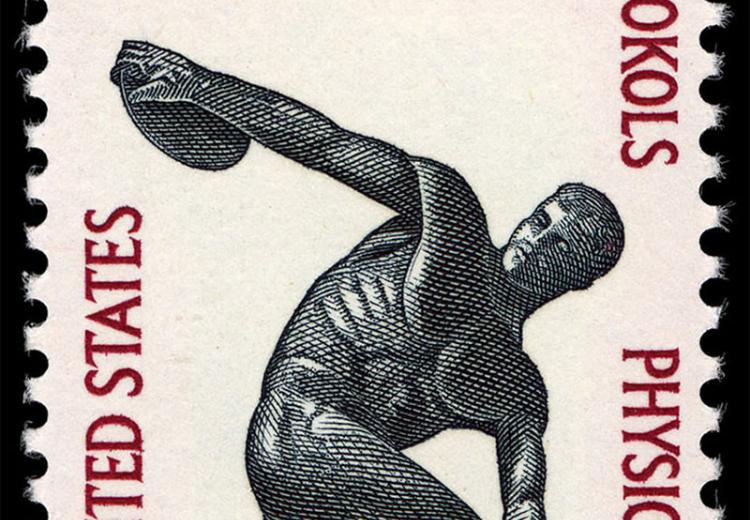The Olympic Medal: It's All Greek to Us!

Physical Fitness Sokol 5-cent U.S. stamp, circa 1965.
"…inquire of Zeus of the flashing thunderbolt, if he has any message to give concerning men whose spirits are seeking to attain great excellence and a breathing-space from toils."
—Excerpt from the Eighth Olympic Ode, by Pindar (c. 522-420 BC)
During the original Olympic games in ancient Greece, champions were not awarded gold, silver, and bronze medals as they are today. Instead, ancient Olympic victors were awarded an olive branch twisted into a circle to form a crown. The wild olive, called kotinos, had deep religious significance for the ancient Greeks. At the ancient Olympics, only the champion was recognized—there were no prizes for runners up. In the modern era, medals recognizing the top three finishers have supplanted the olive-crown as the Olympic award.
Most students can probably recall seeing at least one Olympic medal ceremony. The sight of a triumphant Olympic athlete stooping to receive the gold medal as his or her country's anthem plays is one of the more moving images of each Olympiad. However, students have probably never had a chance to inspect an Olympic medal up-close. If students were to examine the medals awarded at the Athens 2004 games, they would find on both sides of the medal a series of strange markings—some looking remarkably like English letters and others appearing as incomprehensible lines and squiggles.
The string of symbols on both sides of the medal are, of course, Greek letters. The Olympic Movement website had this description of the medal design for the 2004 Athens Olympics: "the main feature of the medals is the Greek character shown on both sides… This is of particular importance, as from now on all Olympic medals will reflect the Greek character of the Games as regards both their origin and their revival." Students can view a graphic of the medal in full detail on the Olympic Movement's Athens 2004 page available through the EDSITEment resource Internet Public Library.
Students are bound to be curious to know what all that Greek writing means. This lesson plan uses an EDSITEment-created Greek alphabet animation to help students "decode" the inscription on the Olympic medal. Because the Olympic medal is both a familiar and mysterious object for students, it presents an ideal prompt to build basic literacy in the Greek alphabet. Thus, this lesson uses the Athens 2004 medal inscription as an elementary "text" to help students practice reading Greek and to help reinforce the link between ancient Greek culture and the Olympic games.
Guiding Questions
How can familiarity with the Greek alphabet help us decipher the inscription on the Athens 2004 Olympic medals?
Learning Objectives
Recognize and identify Greek letters by name.
Read (by sounding out) a string of Greek words.
Explain the content and significance of the inscription on the Athens 2004 Olympic medal.
Identify Greek roots of two English words.
Identify the Greek poet Pindar, and the Greek poetic form called epinicia.
Briefly state Greece's role in Olympic history.
